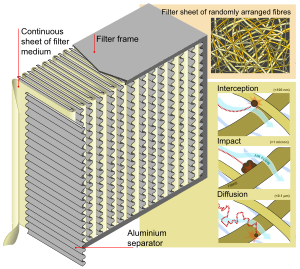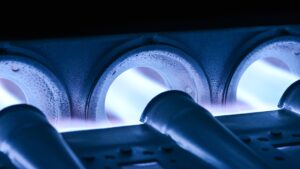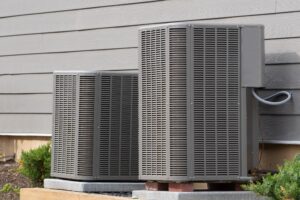Understanding HEPA Filters
From a scientific point of view, the intricate realm of High Efficiency Particulate Air (HEPA) filters holds my unwavering fascination. These technological marvels have become synonymous with pristine air quality and are pivotal components across diverse settings, spanning from the intimate confines of residential abodes to the sterile corridors of medical establishments and the rigorous demands of industrial environments. Embarking on an analytical journey to unravel the profundity of HEPA filters unveils their composition, mechanism of operation, and the quintessential role they play in shaping a healthier indoor air ecosystem.
The Anatomy and Fabrication of HEPA Filters:

Is your HEPA Filter working properly?
HEPA filters are products of meticulous engineering, meticulously designed to ensnare an exhaustive gamut of airborne particles. The fundamental objective is to ensure that air coursing through these filters emerges purged of detrimental contaminants, contributing to an environment of unparalleled purity. At the core of a HEPA filter’s architecture lies a labyrinthine arrangement of delicate fibers, woven into a dense network.
These fibers are typically hewn from materials like fiberglass or synthetic polymers, occasionally blending these elements into a harmonious composite. The juxtaposition of these fibers crafts an intricate tapestry, a cunning mechanism to capture particles seeking passage.
Distinguishing HEPA filters from their conventional counterparts hinges on their extraordinary efficacy in entrapping minuscule particles. These particles, characterized by diameters as minute as 0.3 micrometers, are effortlessly seized by HEPA filters. To place this in a comprehensible context, it’s imperative to note that the thickness of a human hair spans between 50 to 70 micrometers, accentuating the prodigious precision that HEPA filters masterfully wield.
The Intricacies of HEPA Filters in Action
HEPA filters are underpinned by two foundational principles governing their operation: diffusion and interception. When air laden with particles navigates the intricate maze of fibers within the filter, a symphony of mechanisms orchestrates the capture and retention of these particles.
Interception: The grandeur of HEPA filters is manifested through the interception of larger particles. These particles, governed by their size, collide with the filter’s fibers and undergo entrapment. The labyrinthine passages within the filter thwart these particles, compelling them to rest upon the fibers’ surface, ensnared by their voluminous dimensions.
Diffusion: Smaller particles, driven by thermal motion and characterized by Brownian motion, execute erratic trajectories as they intermingle with gas molecules. These frenetic movements culminate in collisions with the filter fibers, leading to their eventual capture.
Direct Impaction: Particles that outsize the interstices between the fibers are thwarted from traversing and, instead, make direct contact with the fibers. This collision eventuates in the particles’ confinement within the filter, embodying an additional line of defense against intrusion.
Electrostatic Attraction: Certain variants of HEPA filters capitalize on electrostatic forces, wielding charges that coerce particles into proximity. As particles course through the filter, these electrostatic interactions bind them to the fibers, akin to an invisible magnetism guiding their fate.
The Pervasive Significance of HEPA Filters
The canvas of HEPA filters extends far beyond their intricate structure and efficient functionality, spanning realms of profound implication for indoor air quality and, by extension, human health.
Efficient Particle Abatement: HEPA filters emerge as frontrunners in capturing an expansive spectrum of particles, embracing dust, pollen, pet dander, mold spores, and even microscopic entities like bacteria and viruses. For individuals afflicted with allergies, asthma, or respiratory sensitivities, the meticulous filtration rendered by HEPA filters translates into respite and improved well-being.
Mitigation of Health Perils: The strategic deployment of HEPA filters in curtailing exposure to airborne allergens and irritants mitigates the likelihood of respiratory afflictions. By curbing the ingress of these particulates, HEPA filters foster an environment conducive to robust health and vitality.
Bulwark Against Airborne Pathogens: Within medical domains, the role of HEPA filters is irrefutably pivotal, intercepting and containing the propagation of infectious diseases. These filters diligently ensnare microorganisms such as bacteria and viruses, significantly curbing the peril of airborne transmission and safeguarding vulnerable populations.
Augmentation of Comfort: The intrinsic potential of HEPA filters to abate the quantum of dust and particulate matter in the air reverberates across indoor spaces, culminating in cleaner surfaces, diminished cleaning frequency, and an augmented sense of overall comfort.
Sentinel of Allergies and Asthma: For individuals grappling with allergies and asthma, the transformative impact of HEPA filters is palpable. By purging allergens and irritants from the atmosphere, these filters induce symptom alleviation and facilitate unobstructed, unhindered respiration.
Optimization of Indoor Air Quality: The curation of superior indoor air quality stands as an imperious objective, particularly for domains where human occupancy is pervasive, such as residences, workplaces, and healthcare precincts. The role of HEPA filters in this pursuit remains nonpareil.
Conformance to Regulatory Benchmarks: In select industries, adherence to stringent air quality benchmarks constitutes an imperative. The prowess of HEPA filters in extirpating particulate matter resonates as an effective conduit to achieving regulatory compliance and fostering an environment characterized by pristine air quality.
Versatility Across Diverse Spheres: Beyond the precincts of residential and medical environments, HEPA filters burgeon with applicability in the industrial and commercial domains. Here, their efficacy in preserving air quality confers a twofold advantage: catalyzing optimal operational processes and safeguarding the health of laborers.




